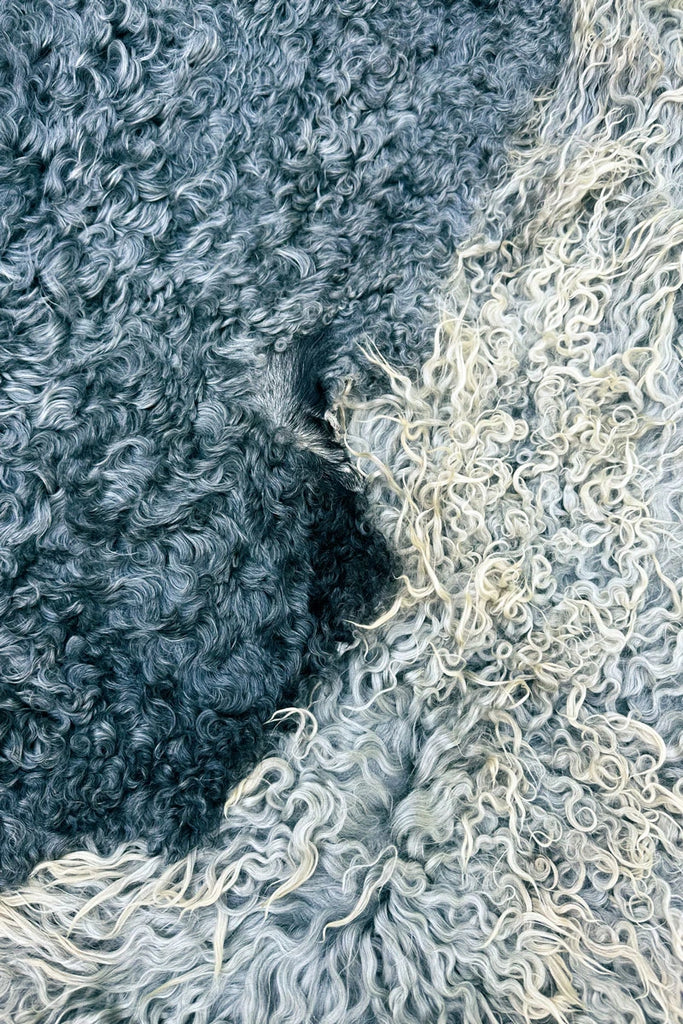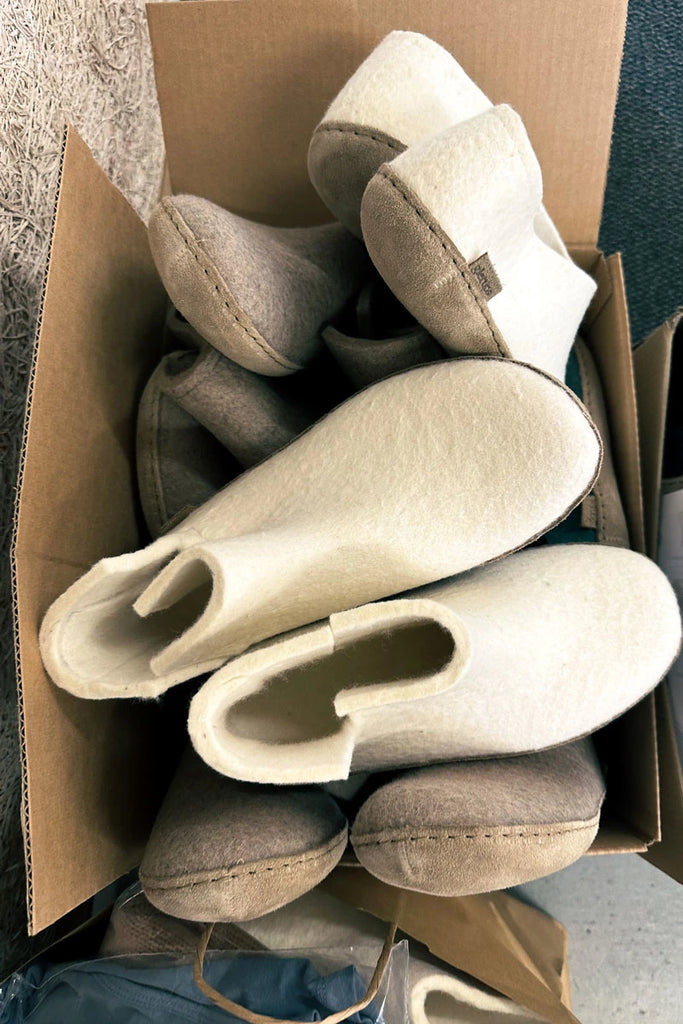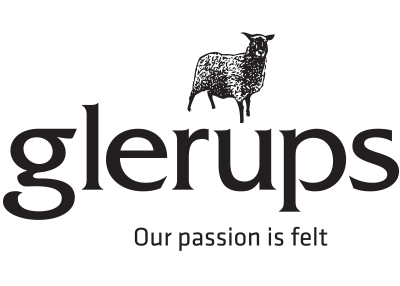Feature photo by Amelia Arvesen
Interview & original article; Arvesen, Amelia. "Inside Glerups, the Family-Run Maker of the World's Coziest Wool Slippers." Field Mag.
With her knuckles covered in soap suds, Nanny Glerup rolls two clumps of raw wool onto what looks like a bamboo placemat. More white soapy foam oozes out onto the table as she squeezes the bundle, rolling it back and forth, adding water with a basting tool. Between the friction and hand-shaping, the fibrous pieces are joining together to look like one big, gray sock.

Photo courtesy Glerups
On this particularly muggy afternoon in June, Nanny, 82, is giving me a demo on felting. “When you put water on it, warm it up, and move it, the fibers become one fiber,” Nanny tells me. This slow and mindful process was how Nanny made her signature 100% wool slippers for the first years of Glerups, which she and her husband, Ove, started 30 years ago just down the road.
We’re in her workshop in Himmerland, Denmark, where the pale blue sky blends into the stippled straw grass, just as some of the old masters portrayed it in oil paintings. A short walk from Nanny’s farmhouse, past her flower garden and two blue-eyed outdoor cats, there’s a stable-turned-craft- room with plywood walls and a low white brick ceiling. It’s decorated with tapestries and old photographs, and two spacious work tables piled with tools and a loom hung with a partially-finished rug take up most of the floorspace.
When I ask her how many pairs of shoes she’s made by hand, she throws up her arms. “I have no idea,” she says. It’s impossible to know because the answer is most likely in the thousands.
At the height of the pandemic, slippers like Glerups saw an uptick in popularity as they became work-from-home essentials. Instead of sneakers and dress shoes, people (including me) were delighted to wear loafers and cushioned socks between their home office and kitchen. At the same time, the Danish philosophy of hygge—surrounding yourself with the good things in life, like coziness, friendship, food, and laughter—also had a resurgence. Stories like “Find hygge this pandemic winter” populated the internet to help us endure lockdown through comfort, nature, gratitude, emotions, and community. We were all searching for something to ground us.
All of these factors put humble, scrappy Glerups in the limelight, though it was already on the trajectory. Today, Glerups is sold worldwide at a rate of about 500,000 pairs per year. The company has a U.S. base in New Hampshire, a production facility in Romania, and the headquarters on the farm in Denmark, where Nanny’s tinkering grew into a profitable endeavor.
Decades ago, Glerups was just a hobby for Nanny. Her first career was as a gym teacher, while Ove worked as a roof thatcher, carpenter, and farmer. The two met in the late 1950s, when she was 18 and he was 17, over their shared interest in gymnastics. Nanny said she thought he was just the nicest young guy in town. They married not long after and had three children.
Nanny and Ove were crafty and resourceful in their own ways, traits that are inherently Scandinavian. Nanny liked to sew, knit, and weave. Ove made beautiful furniture and tools. Sometime in the 1970s, Nanny enrolled in a felting course and made Ove a pair of wool shoes.
“He was so fond of them that one day we were in town, and I discovered that he had his felt boots on and everybody was looking,” Nanny told employees at Glerups’ 25th anniversary celebration.
Then she made more and more shoes. Like many creative people do, Nanny dove deep into the craft. “I am the kind of person who will just say, I do it and I jump,” Nanny said.
Meanwhile, Ove was also quite curious about the wool Nanny was working with, a smooth and lustrous charcoal gray wool from Gotland sheep, a breed native to southern Sweden. They started raising their own flock of sheep, and Ove became involved in the breeding.

Photo by Amelia Arvesen
In 1985, Nanny and Ove relocated their family from the small town of Gislum (close to Aars) to a rundown farm in the countryside where they could be closer to nature and give the sheep more room to roam. It started as a hobby farm, but Nanny also had her sights set on their retirement plan. The 75-acre slice of Denmark’s Northern Jutland was lush and private, with rolling hills and thick forest but also panoramic views.
Throughout the years, Nanny continued to make her novel slippers. At her prime, she could make two pairs of shoes per day. This was sufficient when she was making them for family, friends, and maybe a handful of people in the community who visited her booth at the local craft fair. But once she registered Glerups as an official business in 1993 at the age of 53, Nanny realized she needed help. With her limited capacity, production numbers were low to start. She was even forced to turn down an order of 200 pairs of children’s boots for a buyer in Sweden.
For having such a simple design, Glerups are actually quite complicated in how they’re constructed.
Glerups is probably one of the most Earth- conscious footwear brands on the market.
For having such a simple design, Glerups are actually quite complicated in how they’re constructed. To scale, machinery would have to replicate Nanny’s consistent touch. But the equipment had to be gentle enough to not rip the fibers and aggressive enough to heat and shrink the wool to the perfect fit.
After years of trial and error improvising tools—including a concrete mixer—Nanny found a carding machine (which cleans and disentangles wool) from the 1930s during a trip to England. At Glerups, it became lovingly known as The Old Lady.
In business and in life, Nanny and Ove balanced each other out. Nanny was the creative thinker and dreamer while Ove was practical about money and resourceful about finding solutions. “I used to say it was me who had the ideas, but it was Ove who made the tools,” said Nanny.
They were also quite social. Ove co-founded the Danish Gotland Sheep Society and was aptly nicknamed “The Gotfather.” In those early days, the Glerups sourced wool from their neighbors and other sheep farmers in the country, where they could see the farm and ensure a good quality of life for the sheep. But as production increased, there wasn’t enough Gotland wool to go around, and business was getting expensive
in Denmark. Around 2005, they established the factory in Romania. Then they started sourcing more wool from New Zealand’s bounty while still remaining close friends with many of the sheep farmers in Denmark.
In every pair of Glerups sold today, the felted sock is created from a special and consistent blend of wool fibers. Long, shiny gray wool from local Gotland sheep offers the softness, while the pure white wool from New Zealand provides structure and rigidity. Slippers come in three heights—slip-on, shoe, and boot—with a choice of either a natural rubber or leather outsole.
You won’t see the word “sustainable” in any of their marketing materials, even though, by today’s standard, Glerups is probably one of the most Earth-conscious footwear brands on the market. The leather sole is natural, the wool is natural, the stitching is natural. In everything Glerups does, they take into consideration the impact on the land, animals, and people.
Despite the small business’s success, recent years have been particularly tough for Nanny and the Glerups community. After a battle with cancer, Ove died in 2022. Nanny has never been shy about showing her emotional side—employees tell me she had the whole room in tears during her 25th anniversary presentation—and the tears come especially easy these days when she tells stories of Ove. During the tough times for the business, when Nanny was close to giving up on their dream, Ove was right there supporting and encouraging her. He helped her believe that all the trials and tribulations were worth the fruits of their labor. (In this case, cozy slippers.)

Photo by Amelia Arvesen
The business is in good hands, too. Their son, Jesper Glerup, and his business partner, Allan Timm, are shepherding Glerups into its next evolution. Over the past few years, they’ve expanded the Romania factory by adding solar-powered buildings and a modern felting machine, the biggest investment to date. And a new factory in Poland will be dedicated to Glerups’ Project Zero Waste initiative, in which they’re using leftover wool to create new pairs of Glerups as well as home goods and other types of products with partners.
When they need a consultant though, Nanny is not far away; usually gardening, weaving, or making a rhubarb tart at her farmhouse. She also serves as a board member and acts as their compass. And Nanny and Ove’s devotion and love for each other and Glerups still permeates throughout the company—from the daily team meals at headquarters to her gentle one-on- one chats with the employees about wool, felting, products, and production.
“It’s a really nice feeling that everything we’ve been fighting for has succeeded,” Nanny wrote. “Many have told us that it’s been like a fairy tale and I guess that’s true. Like in fairy tales, we have been through challenges and rough patches to arrive at a happy ending.”
